Effective Management Communication Strategies and Examples
VerifiedAdded on 2021/04/16
|9
|2721
|35
Report
AI Summary
This report delves into the critical role of communication within organizations, emphasizing its impact on operational smoothness and team culture. It highlights real-life examples of successful communication, such as Buffer's transparent practices, and unsuccessful communication, exemplified by British Petroleum's oil spill. The report analyzes factors that promote effective communication, including organizational structure, communication mediums, and positive leadership, while also identifying barriers like negative leadership, cultural differences, self-esteem, lack of trust, inefficient communication mediums, and poor management skills. The analysis underscores the significance of robust communication strategies for organizational success, offering valuable insights into both best practices and potential pitfalls.
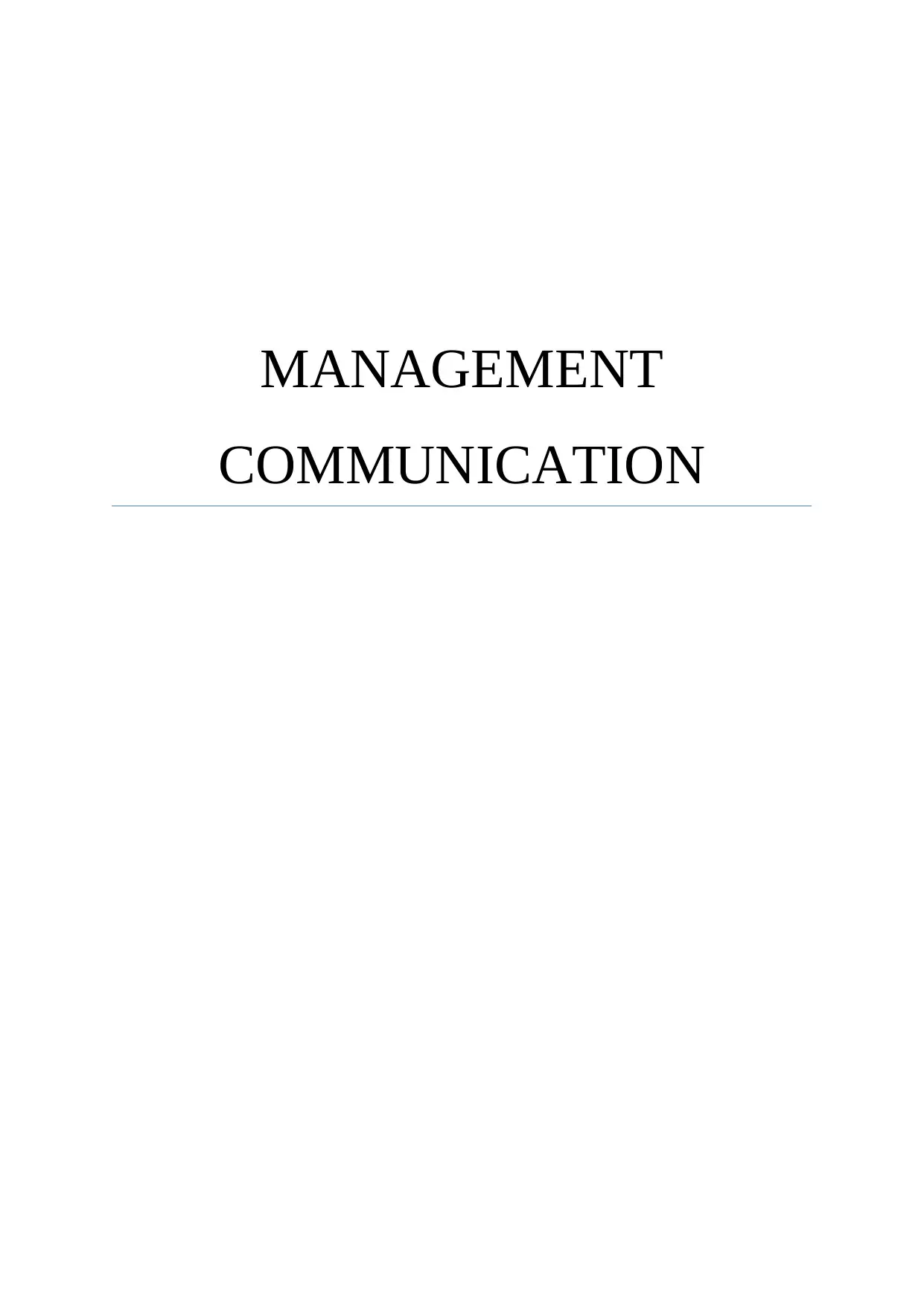
MANAGEMENT
COMMUNICATION
COMMUNICATION
Paraphrase This Document
Need a fresh take? Get an instant paraphrase of this document with our AI Paraphraser
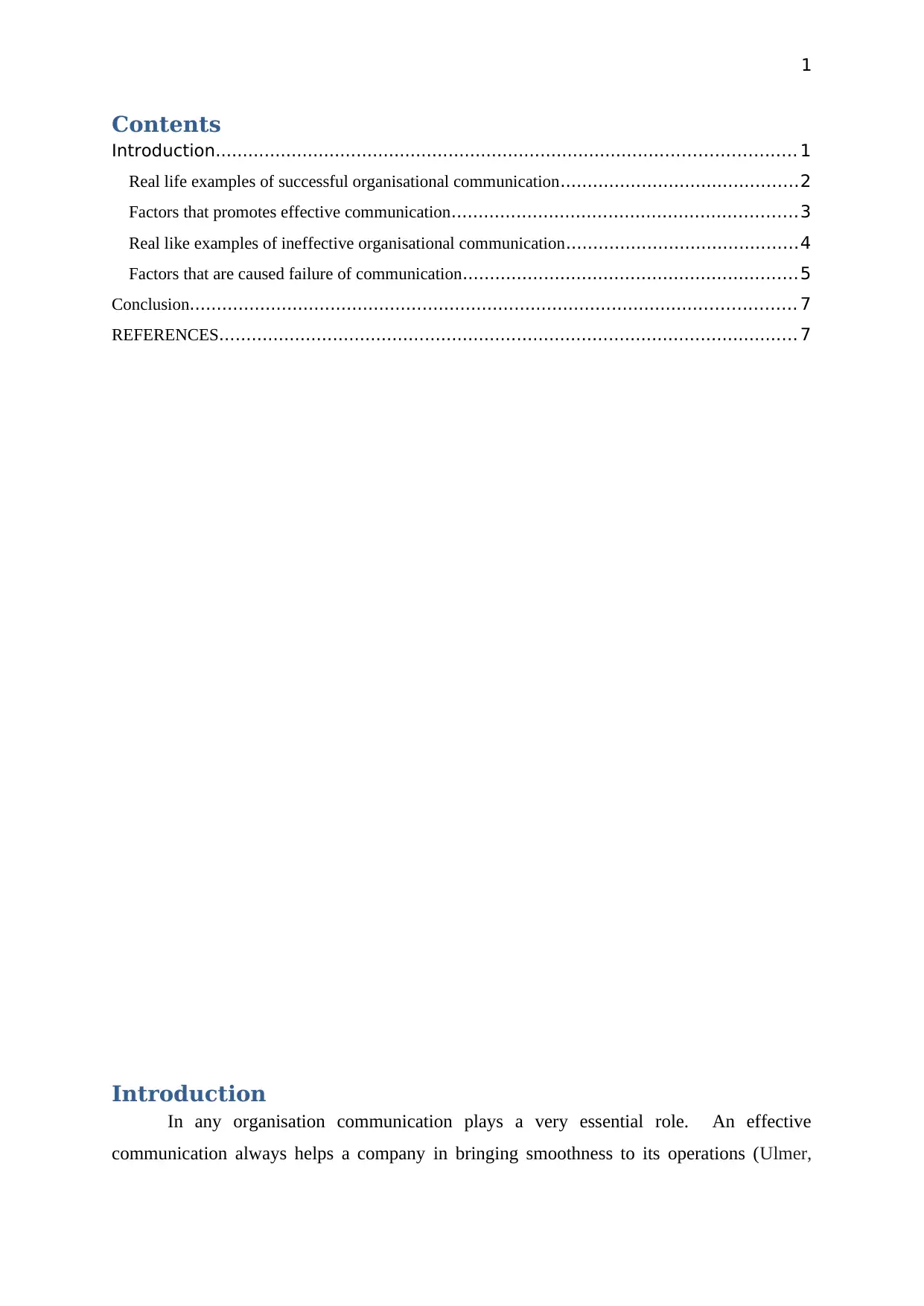
1
Contents
Introduction........................................................................................................... 1
Real life examples of successful organisational communication............................................2
Factors that promotes effective communication................................................................3
Real like examples of ineffective organisational communication...........................................4
Factors that are caused failure of communication..............................................................5
Conclusion................................................................................................................ 7
REFERENCES........................................................................................................... 7
Introduction
In any organisation communication plays a very essential role. An effective
communication always helps a company in bringing smoothness to its operations (Ulmer,
Contents
Introduction........................................................................................................... 1
Real life examples of successful organisational communication............................................2
Factors that promotes effective communication................................................................3
Real like examples of ineffective organisational communication...........................................4
Factors that are caused failure of communication..............................................................5
Conclusion................................................................................................................ 7
REFERENCES........................................................................................................... 7
Introduction
In any organisation communication plays a very essential role. An effective
communication always helps a company in bringing smoothness to its operations (Ulmer,
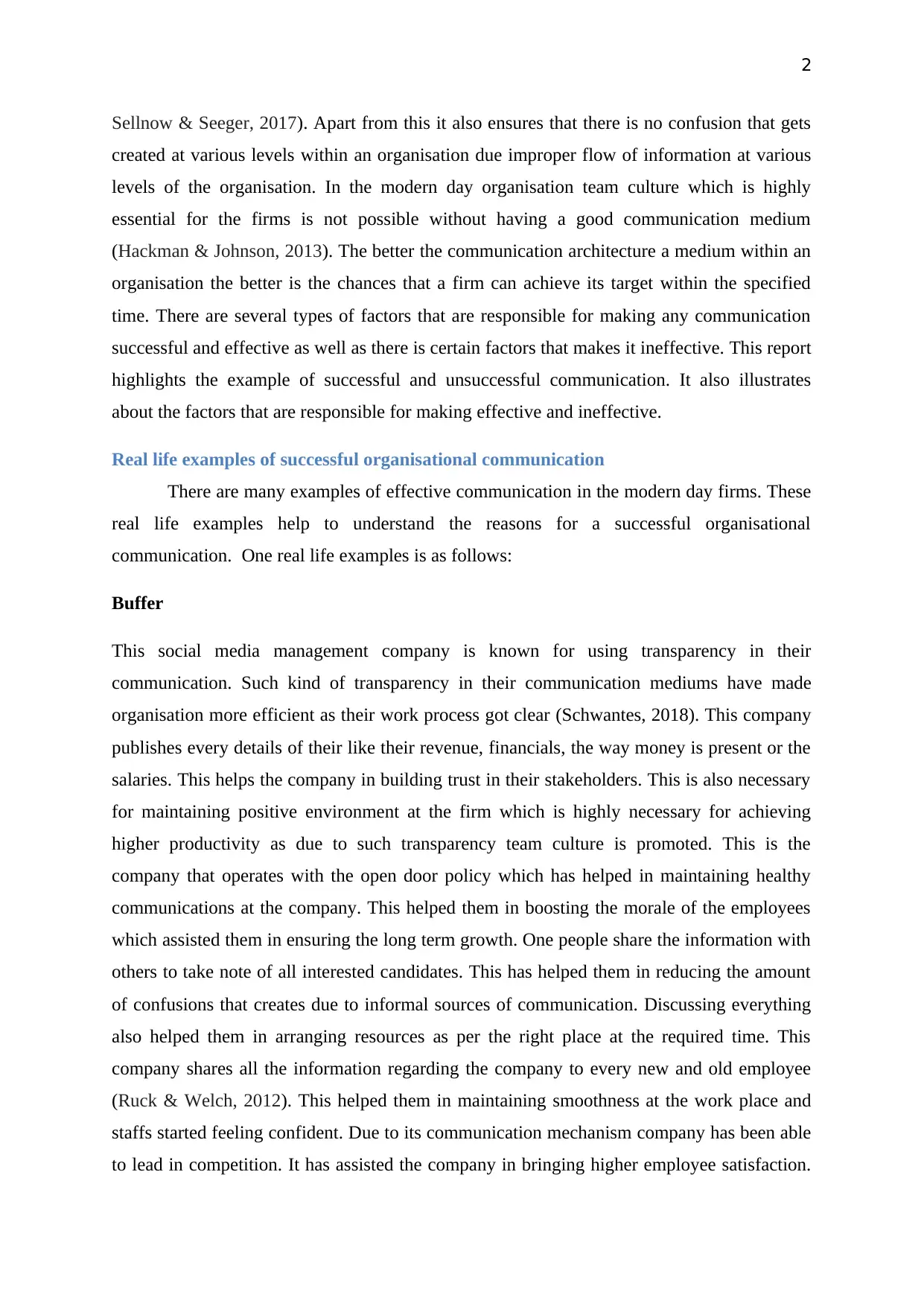
2
Sellnow & Seeger, 2017). Apart from this it also ensures that there is no confusion that gets
created at various levels within an organisation due improper flow of information at various
levels of the organisation. In the modern day organisation team culture which is highly
essential for the firms is not possible without having a good communication medium
(Hackman & Johnson, 2013). The better the communication architecture a medium within an
organisation the better is the chances that a firm can achieve its target within the specified
time. There are several types of factors that are responsible for making any communication
successful and effective as well as there is certain factors that makes it ineffective. This report
highlights the example of successful and unsuccessful communication. It also illustrates
about the factors that are responsible for making effective and ineffective.
Real life examples of successful organisational communication
There are many examples of effective communication in the modern day firms. These
real life examples help to understand the reasons for a successful organisational
communication. One real life examples is as follows:
Buffer
This social media management company is known for using transparency in their
communication. Such kind of transparency in their communication mediums have made
organisation more efficient as their work process got clear (Schwantes, 2018). This company
publishes every details of their like their revenue, financials, the way money is present or the
salaries. This helps the company in building trust in their stakeholders. This is also necessary
for maintaining positive environment at the firm which is highly necessary for achieving
higher productivity as due to such transparency team culture is promoted. This is the
company that operates with the open door policy which has helped in maintaining healthy
communications at the company. This helped them in boosting the morale of the employees
which assisted them in ensuring the long term growth. One people share the information with
others to take note of all interested candidates. This has helped them in reducing the amount
of confusions that creates due to informal sources of communication. Discussing everything
also helped them in arranging resources as per the right place at the required time. This
company shares all the information regarding the company to every new and old employee
(Ruck & Welch, 2012). This helped them in maintaining smoothness at the work place and
staffs started feeling confident. Due to its communication mechanism company has been able
to lead in competition. It has assisted the company in bringing higher employee satisfaction.
Sellnow & Seeger, 2017). Apart from this it also ensures that there is no confusion that gets
created at various levels within an organisation due improper flow of information at various
levels of the organisation. In the modern day organisation team culture which is highly
essential for the firms is not possible without having a good communication medium
(Hackman & Johnson, 2013). The better the communication architecture a medium within an
organisation the better is the chances that a firm can achieve its target within the specified
time. There are several types of factors that are responsible for making any communication
successful and effective as well as there is certain factors that makes it ineffective. This report
highlights the example of successful and unsuccessful communication. It also illustrates
about the factors that are responsible for making effective and ineffective.
Real life examples of successful organisational communication
There are many examples of effective communication in the modern day firms. These
real life examples help to understand the reasons for a successful organisational
communication. One real life examples is as follows:
Buffer
This social media management company is known for using transparency in their
communication. Such kind of transparency in their communication mediums have made
organisation more efficient as their work process got clear (Schwantes, 2018). This company
publishes every details of their like their revenue, financials, the way money is present or the
salaries. This helps the company in building trust in their stakeholders. This is also necessary
for maintaining positive environment at the firm which is highly necessary for achieving
higher productivity as due to such transparency team culture is promoted. This is the
company that operates with the open door policy which has helped in maintaining healthy
communications at the company. This helped them in boosting the morale of the employees
which assisted them in ensuring the long term growth. One people share the information with
others to take note of all interested candidates. This has helped them in reducing the amount
of confusions that creates due to informal sources of communication. Discussing everything
also helped them in arranging resources as per the right place at the required time. This
company shares all the information regarding the company to every new and old employee
(Ruck & Welch, 2012). This helped them in maintaining smoothness at the work place and
staffs started feeling confident. Due to its communication mechanism company has been able
to lead in competition. It has assisted the company in bringing higher employee satisfaction.
⊘ This is a preview!⊘
Do you want full access?
Subscribe today to unlock all pages.

Trusted by 1+ million students worldwide
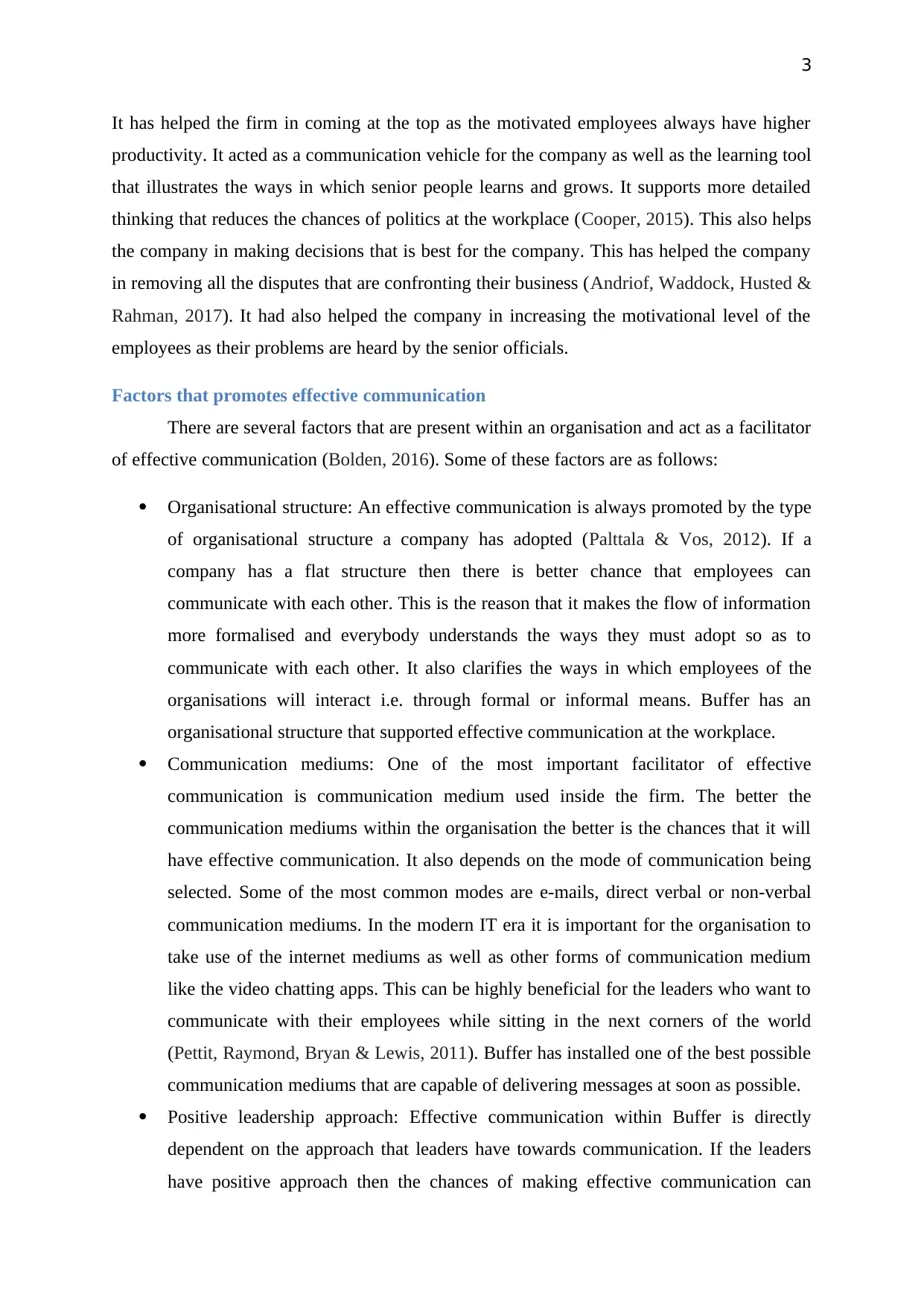
3
It has helped the firm in coming at the top as the motivated employees always have higher
productivity. It acted as a communication vehicle for the company as well as the learning tool
that illustrates the ways in which senior people learns and grows. It supports more detailed
thinking that reduces the chances of politics at the workplace (Cooper, 2015). This also helps
the company in making decisions that is best for the company. This has helped the company
in removing all the disputes that are confronting their business (Andriof, Waddock, Husted &
Rahman, 2017). It had also helped the company in increasing the motivational level of the
employees as their problems are heard by the senior officials.
Factors that promotes effective communication
There are several factors that are present within an organisation and act as a facilitator
of effective communication (Bolden, 2016). Some of these factors are as follows:
Organisational structure: An effective communication is always promoted by the type
of organisational structure a company has adopted (Palttala & Vos, 2012). If a
company has a flat structure then there is better chance that employees can
communicate with each other. This is the reason that it makes the flow of information
more formalised and everybody understands the ways they must adopt so as to
communicate with each other. It also clarifies the ways in which employees of the
organisations will interact i.e. through formal or informal means. Buffer has an
organisational structure that supported effective communication at the workplace.
Communication mediums: One of the most important facilitator of effective
communication is communication medium used inside the firm. The better the
communication mediums within the organisation the better is the chances that it will
have effective communication. It also depends on the mode of communication being
selected. Some of the most common modes are e-mails, direct verbal or non-verbal
communication mediums. In the modern IT era it is important for the organisation to
take use of the internet mediums as well as other forms of communication medium
like the video chatting apps. This can be highly beneficial for the leaders who want to
communicate with their employees while sitting in the next corners of the world
(Pettit, Raymond, Bryan & Lewis, 2011). Buffer has installed one of the best possible
communication mediums that are capable of delivering messages at soon as possible.
Positive leadership approach: Effective communication within Buffer is directly
dependent on the approach that leaders have towards communication. If the leaders
have positive approach then the chances of making effective communication can
It has helped the firm in coming at the top as the motivated employees always have higher
productivity. It acted as a communication vehicle for the company as well as the learning tool
that illustrates the ways in which senior people learns and grows. It supports more detailed
thinking that reduces the chances of politics at the workplace (Cooper, 2015). This also helps
the company in making decisions that is best for the company. This has helped the company
in removing all the disputes that are confronting their business (Andriof, Waddock, Husted &
Rahman, 2017). It had also helped the company in increasing the motivational level of the
employees as their problems are heard by the senior officials.
Factors that promotes effective communication
There are several factors that are present within an organisation and act as a facilitator
of effective communication (Bolden, 2016). Some of these factors are as follows:
Organisational structure: An effective communication is always promoted by the type
of organisational structure a company has adopted (Palttala & Vos, 2012). If a
company has a flat structure then there is better chance that employees can
communicate with each other. This is the reason that it makes the flow of information
more formalised and everybody understands the ways they must adopt so as to
communicate with each other. It also clarifies the ways in which employees of the
organisations will interact i.e. through formal or informal means. Buffer has an
organisational structure that supported effective communication at the workplace.
Communication mediums: One of the most important facilitator of effective
communication is communication medium used inside the firm. The better the
communication mediums within the organisation the better is the chances that it will
have effective communication. It also depends on the mode of communication being
selected. Some of the most common modes are e-mails, direct verbal or non-verbal
communication mediums. In the modern IT era it is important for the organisation to
take use of the internet mediums as well as other forms of communication medium
like the video chatting apps. This can be highly beneficial for the leaders who want to
communicate with their employees while sitting in the next corners of the world
(Pettit, Raymond, Bryan & Lewis, 2011). Buffer has installed one of the best possible
communication mediums that are capable of delivering messages at soon as possible.
Positive leadership approach: Effective communication within Buffer is directly
dependent on the approach that leaders have towards communication. If the leaders
have positive approach then the chances of making effective communication can
Paraphrase This Document
Need a fresh take? Get an instant paraphrase of this document with our AI Paraphraser
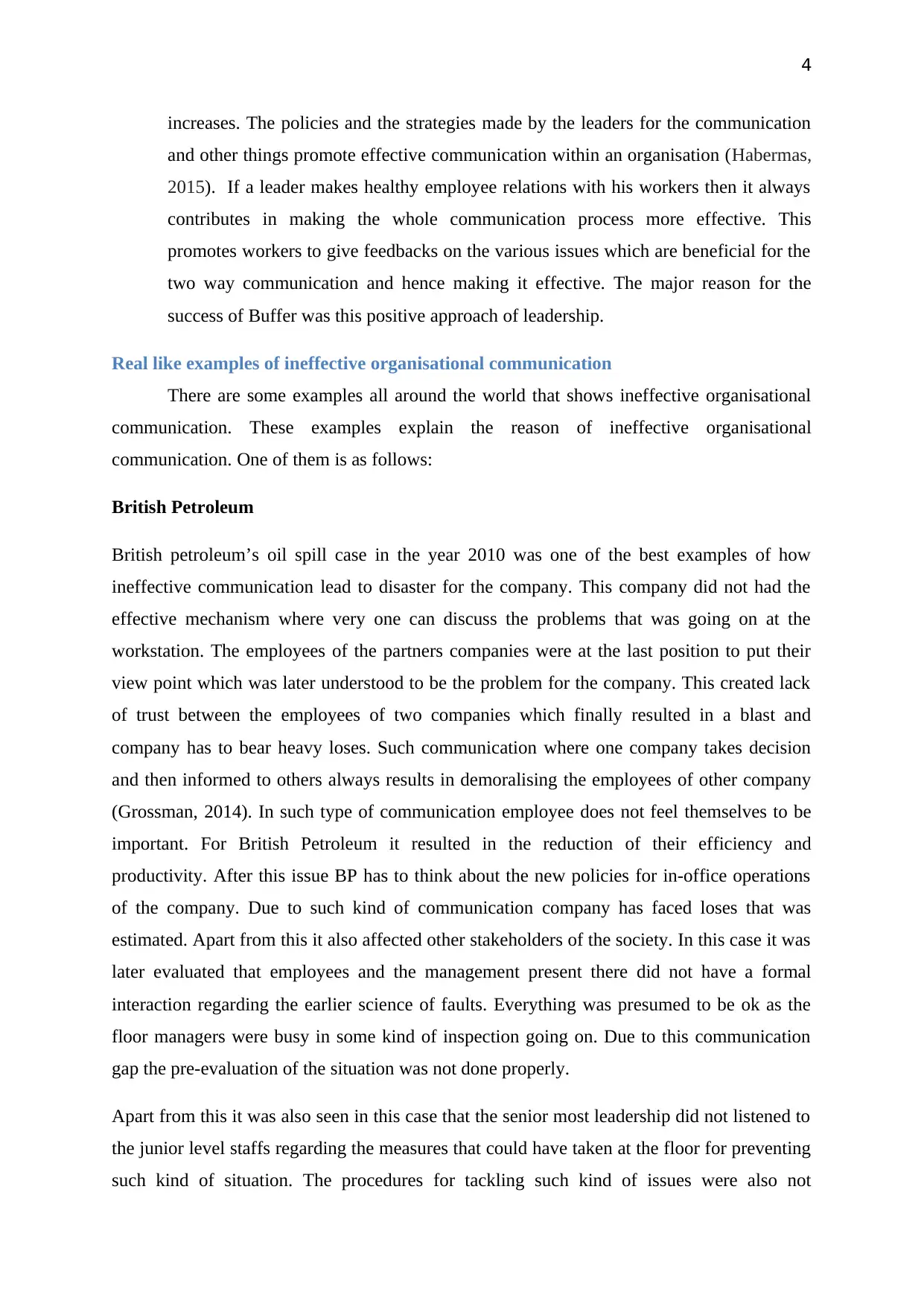
4
increases. The policies and the strategies made by the leaders for the communication
and other things promote effective communication within an organisation (Habermas,
2015). If a leader makes healthy employee relations with his workers then it always
contributes in making the whole communication process more effective. This
promotes workers to give feedbacks on the various issues which are beneficial for the
two way communication and hence making it effective. The major reason for the
success of Buffer was this positive approach of leadership.
Real like examples of ineffective organisational communication
There are some examples all around the world that shows ineffective organisational
communication. These examples explain the reason of ineffective organisational
communication. One of them is as follows:
British Petroleum
British petroleum’s oil spill case in the year 2010 was one of the best examples of how
ineffective communication lead to disaster for the company. This company did not had the
effective mechanism where very one can discuss the problems that was going on at the
workstation. The employees of the partners companies were at the last position to put their
view point which was later understood to be the problem for the company. This created lack
of trust between the employees of two companies which finally resulted in a blast and
company has to bear heavy loses. Such communication where one company takes decision
and then informed to others always results in demoralising the employees of other company
(Grossman, 2014). In such type of communication employee does not feel themselves to be
important. For British Petroleum it resulted in the reduction of their efficiency and
productivity. After this issue BP has to think about the new policies for in-office operations
of the company. Due to such kind of communication company has faced loses that was
estimated. Apart from this it also affected other stakeholders of the society. In this case it was
later evaluated that employees and the management present there did not have a formal
interaction regarding the earlier science of faults. Everything was presumed to be ok as the
floor managers were busy in some kind of inspection going on. Due to this communication
gap the pre-evaluation of the situation was not done properly.
Apart from this it was also seen in this case that the senior most leadership did not listened to
the junior level staffs regarding the measures that could have taken at the floor for preventing
such kind of situation. The procedures for tackling such kind of issues were also not
increases. The policies and the strategies made by the leaders for the communication
and other things promote effective communication within an organisation (Habermas,
2015). If a leader makes healthy employee relations with his workers then it always
contributes in making the whole communication process more effective. This
promotes workers to give feedbacks on the various issues which are beneficial for the
two way communication and hence making it effective. The major reason for the
success of Buffer was this positive approach of leadership.
Real like examples of ineffective organisational communication
There are some examples all around the world that shows ineffective organisational
communication. These examples explain the reason of ineffective organisational
communication. One of them is as follows:
British Petroleum
British petroleum’s oil spill case in the year 2010 was one of the best examples of how
ineffective communication lead to disaster for the company. This company did not had the
effective mechanism where very one can discuss the problems that was going on at the
workstation. The employees of the partners companies were at the last position to put their
view point which was later understood to be the problem for the company. This created lack
of trust between the employees of two companies which finally resulted in a blast and
company has to bear heavy loses. Such communication where one company takes decision
and then informed to others always results in demoralising the employees of other company
(Grossman, 2014). In such type of communication employee does not feel themselves to be
important. For British Petroleum it resulted in the reduction of their efficiency and
productivity. After this issue BP has to think about the new policies for in-office operations
of the company. Due to such kind of communication company has faced loses that was
estimated. Apart from this it also affected other stakeholders of the society. In this case it was
later evaluated that employees and the management present there did not have a formal
interaction regarding the earlier science of faults. Everything was presumed to be ok as the
floor managers were busy in some kind of inspection going on. Due to this communication
gap the pre-evaluation of the situation was not done properly.
Apart from this it was also seen in this case that the senior most leadership did not listened to
the junior level staffs regarding the measures that could have taken at the floor for preventing
such kind of situation. The procedures for tackling such kind of issues were also not
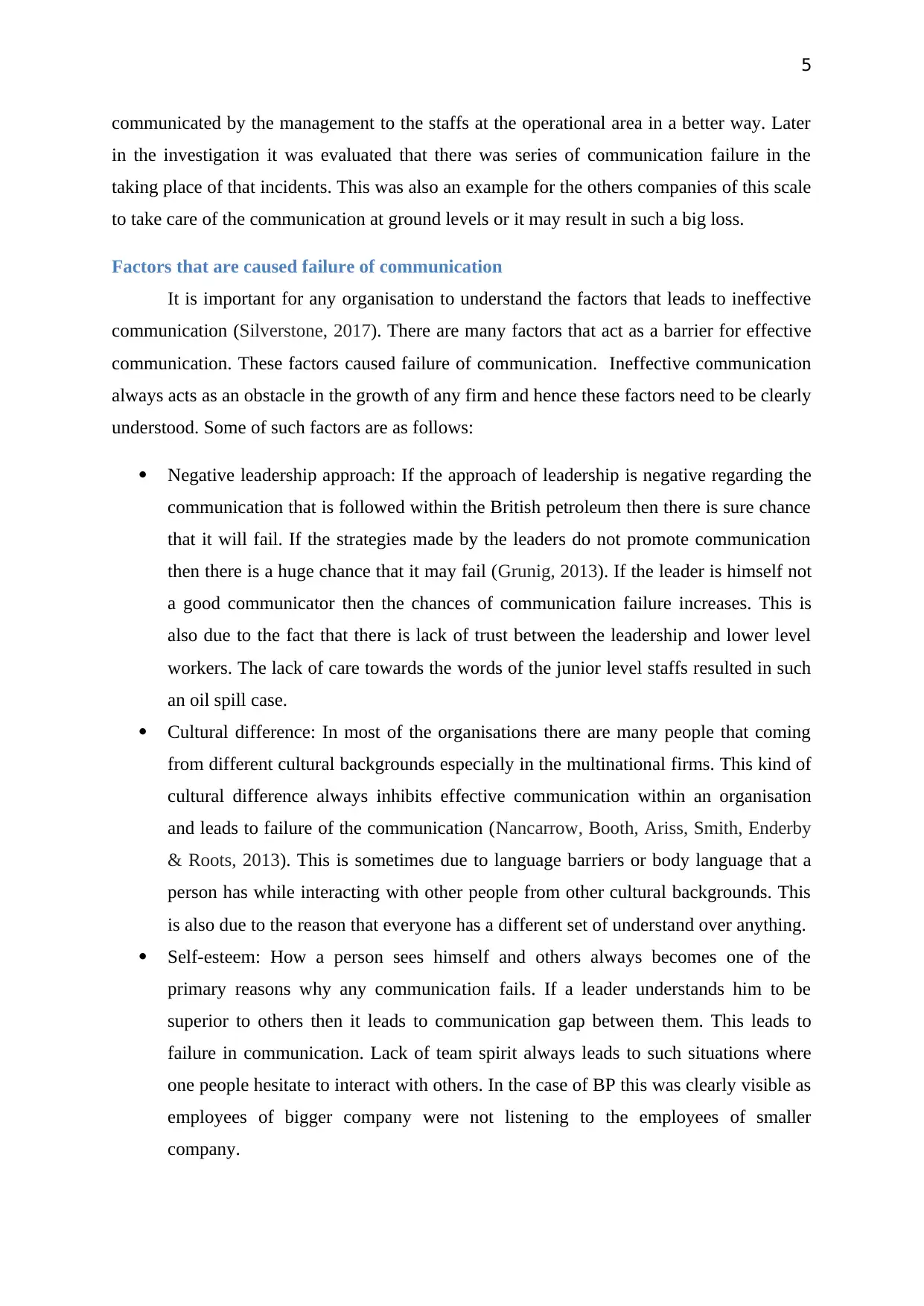
5
communicated by the management to the staffs at the operational area in a better way. Later
in the investigation it was evaluated that there was series of communication failure in the
taking place of that incidents. This was also an example for the others companies of this scale
to take care of the communication at ground levels or it may result in such a big loss.
Factors that are caused failure of communication
It is important for any organisation to understand the factors that leads to ineffective
communication (Silverstone, 2017). There are many factors that act as a barrier for effective
communication. These factors caused failure of communication. Ineffective communication
always acts as an obstacle in the growth of any firm and hence these factors need to be clearly
understood. Some of such factors are as follows:
Negative leadership approach: If the approach of leadership is negative regarding the
communication that is followed within the British petroleum then there is sure chance
that it will fail. If the strategies made by the leaders do not promote communication
then there is a huge chance that it may fail (Grunig, 2013). If the leader is himself not
a good communicator then the chances of communication failure increases. This is
also due to the fact that there is lack of trust between the leadership and lower level
workers. The lack of care towards the words of the junior level staffs resulted in such
an oil spill case.
Cultural difference: In most of the organisations there are many people that coming
from different cultural backgrounds especially in the multinational firms. This kind of
cultural difference always inhibits effective communication within an organisation
and leads to failure of the communication (Nancarrow, Booth, Ariss, Smith, Enderby
& Roots, 2013). This is sometimes due to language barriers or body language that a
person has while interacting with other people from other cultural backgrounds. This
is also due to the reason that everyone has a different set of understand over anything.
Self-esteem: How a person sees himself and others always becomes one of the
primary reasons why any communication fails. If a leader understands him to be
superior to others then it leads to communication gap between them. This leads to
failure in communication. Lack of team spirit always leads to such situations where
one people hesitate to interact with others. In the case of BP this was clearly visible as
employees of bigger company were not listening to the employees of smaller
company.
communicated by the management to the staffs at the operational area in a better way. Later
in the investigation it was evaluated that there was series of communication failure in the
taking place of that incidents. This was also an example for the others companies of this scale
to take care of the communication at ground levels or it may result in such a big loss.
Factors that are caused failure of communication
It is important for any organisation to understand the factors that leads to ineffective
communication (Silverstone, 2017). There are many factors that act as a barrier for effective
communication. These factors caused failure of communication. Ineffective communication
always acts as an obstacle in the growth of any firm and hence these factors need to be clearly
understood. Some of such factors are as follows:
Negative leadership approach: If the approach of leadership is negative regarding the
communication that is followed within the British petroleum then there is sure chance
that it will fail. If the strategies made by the leaders do not promote communication
then there is a huge chance that it may fail (Grunig, 2013). If the leader is himself not
a good communicator then the chances of communication failure increases. This is
also due to the fact that there is lack of trust between the leadership and lower level
workers. The lack of care towards the words of the junior level staffs resulted in such
an oil spill case.
Cultural difference: In most of the organisations there are many people that coming
from different cultural backgrounds especially in the multinational firms. This kind of
cultural difference always inhibits effective communication within an organisation
and leads to failure of the communication (Nancarrow, Booth, Ariss, Smith, Enderby
& Roots, 2013). This is sometimes due to language barriers or body language that a
person has while interacting with other people from other cultural backgrounds. This
is also due to the reason that everyone has a different set of understand over anything.
Self-esteem: How a person sees himself and others always becomes one of the
primary reasons why any communication fails. If a leader understands him to be
superior to others then it leads to communication gap between them. This leads to
failure in communication. Lack of team spirit always leads to such situations where
one people hesitate to interact with others. In the case of BP this was clearly visible as
employees of bigger company were not listening to the employees of smaller
company.
⊘ This is a preview!⊘
Do you want full access?
Subscribe today to unlock all pages.

Trusted by 1+ million students worldwide
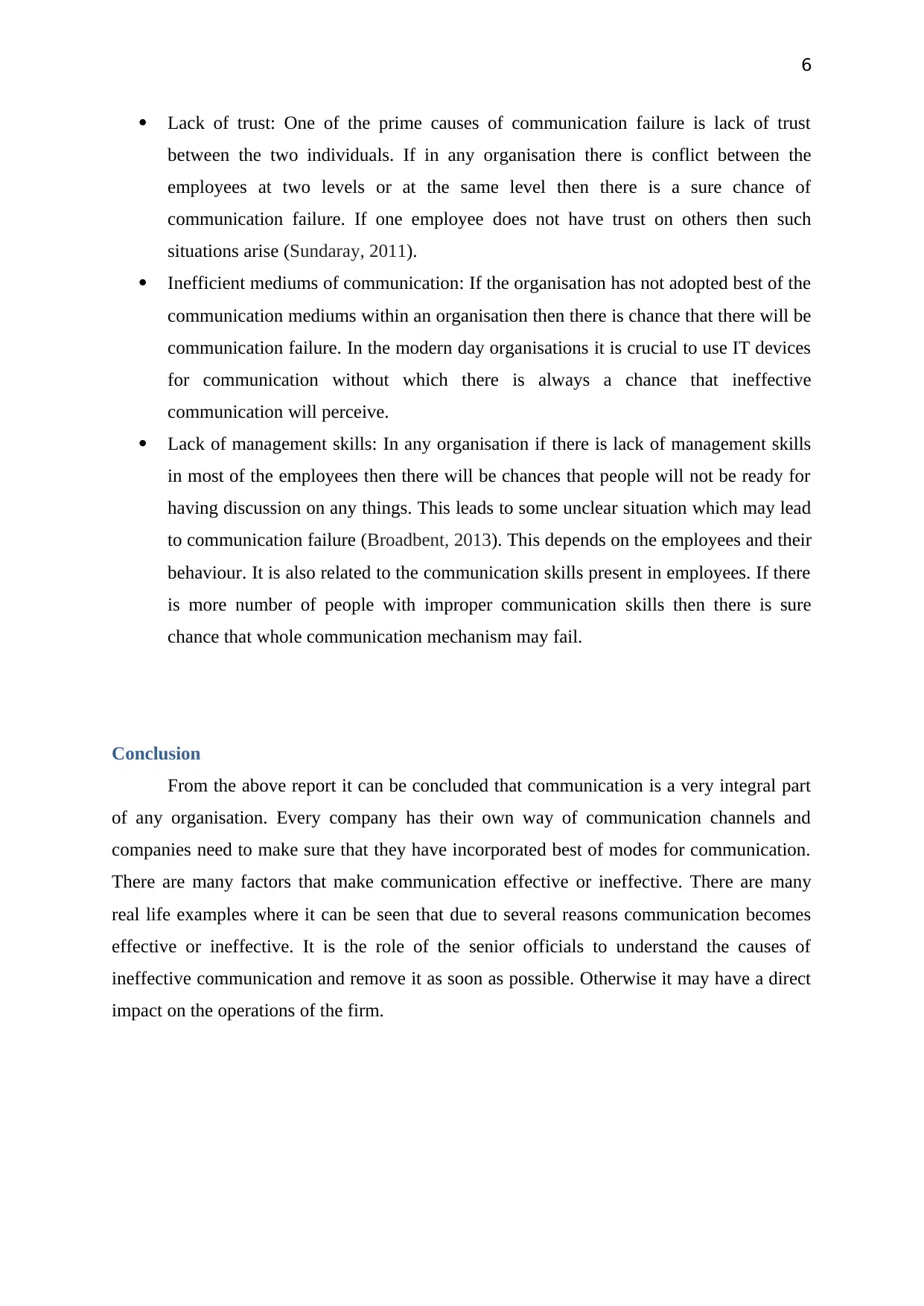
6
Lack of trust: One of the prime causes of communication failure is lack of trust
between the two individuals. If in any organisation there is conflict between the
employees at two levels or at the same level then there is a sure chance of
communication failure. If one employee does not have trust on others then such
situations arise (Sundaray, 2011).
Inefficient mediums of communication: If the organisation has not adopted best of the
communication mediums within an organisation then there is chance that there will be
communication failure. In the modern day organisations it is crucial to use IT devices
for communication without which there is always a chance that ineffective
communication will perceive.
Lack of management skills: In any organisation if there is lack of management skills
in most of the employees then there will be chances that people will not be ready for
having discussion on any things. This leads to some unclear situation which may lead
to communication failure (Broadbent, 2013). This depends on the employees and their
behaviour. It is also related to the communication skills present in employees. If there
is more number of people with improper communication skills then there is sure
chance that whole communication mechanism may fail.
Conclusion
From the above report it can be concluded that communication is a very integral part
of any organisation. Every company has their own way of communication channels and
companies need to make sure that they have incorporated best of modes for communication.
There are many factors that make communication effective or ineffective. There are many
real life examples where it can be seen that due to several reasons communication becomes
effective or ineffective. It is the role of the senior officials to understand the causes of
ineffective communication and remove it as soon as possible. Otherwise it may have a direct
impact on the operations of the firm.
Lack of trust: One of the prime causes of communication failure is lack of trust
between the two individuals. If in any organisation there is conflict between the
employees at two levels or at the same level then there is a sure chance of
communication failure. If one employee does not have trust on others then such
situations arise (Sundaray, 2011).
Inefficient mediums of communication: If the organisation has not adopted best of the
communication mediums within an organisation then there is chance that there will be
communication failure. In the modern day organisations it is crucial to use IT devices
for communication without which there is always a chance that ineffective
communication will perceive.
Lack of management skills: In any organisation if there is lack of management skills
in most of the employees then there will be chances that people will not be ready for
having discussion on any things. This leads to some unclear situation which may lead
to communication failure (Broadbent, 2013). This depends on the employees and their
behaviour. It is also related to the communication skills present in employees. If there
is more number of people with improper communication skills then there is sure
chance that whole communication mechanism may fail.
Conclusion
From the above report it can be concluded that communication is a very integral part
of any organisation. Every company has their own way of communication channels and
companies need to make sure that they have incorporated best of modes for communication.
There are many factors that make communication effective or ineffective. There are many
real life examples where it can be seen that due to several reasons communication becomes
effective or ineffective. It is the role of the senior officials to understand the causes of
ineffective communication and remove it as soon as possible. Otherwise it may have a direct
impact on the operations of the firm.
Paraphrase This Document
Need a fresh take? Get an instant paraphrase of this document with our AI Paraphraser
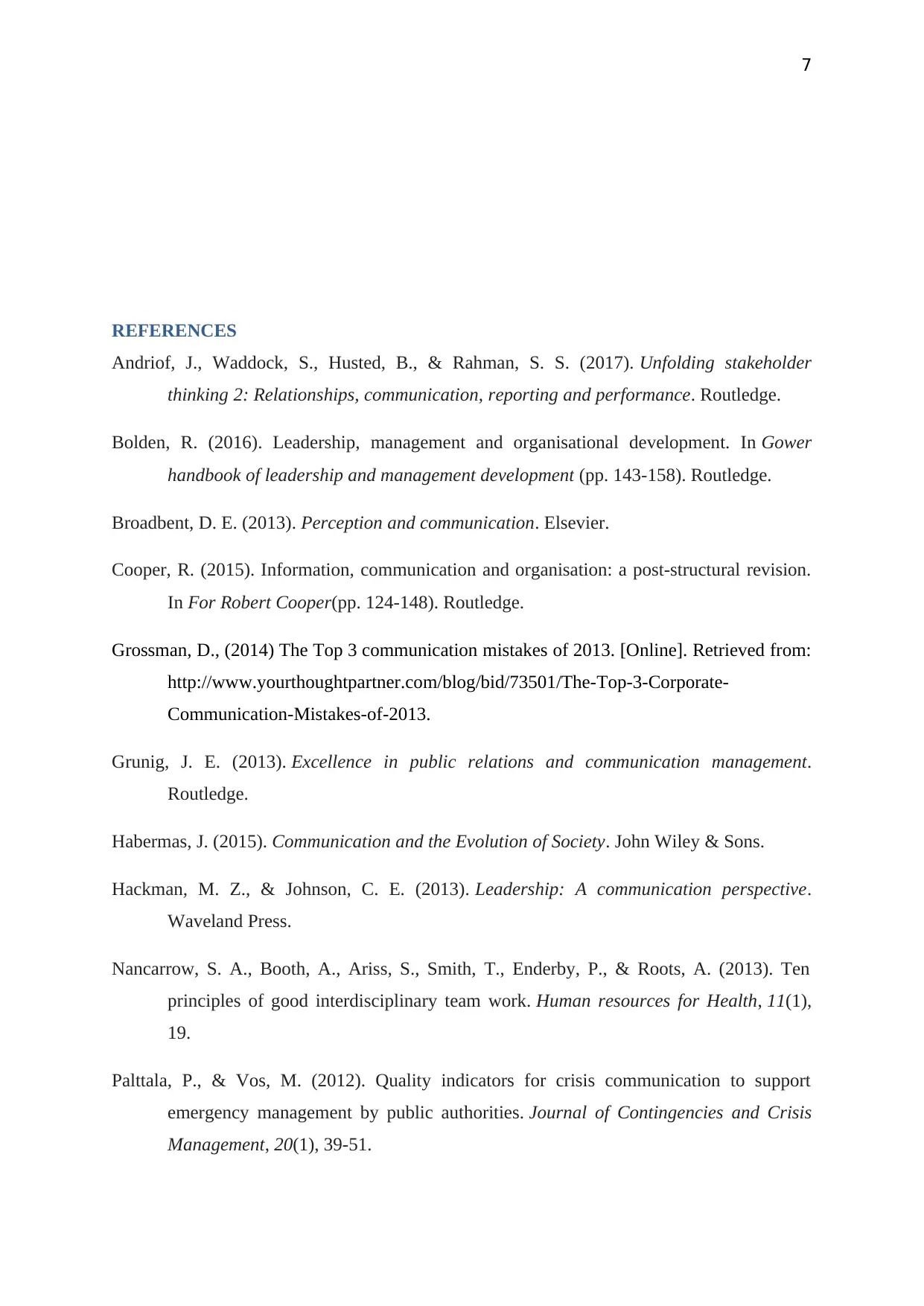
7
REFERENCES
Andriof, J., Waddock, S., Husted, B., & Rahman, S. S. (2017). Unfolding stakeholder
thinking 2: Relationships, communication, reporting and performance. Routledge.
Bolden, R. (2016). Leadership, management and organisational development. In Gower
handbook of leadership and management development (pp. 143-158). Routledge.
Broadbent, D. E. (2013). Perception and communication. Elsevier.
Cooper, R. (2015). Information, communication and organisation: a post-structural revision.
In For Robert Cooper(pp. 124-148). Routledge.
Grossman, D., (2014) The Top 3 communication mistakes of 2013. [Online]. Retrieved from:
http://www.yourthoughtpartner.com/blog/bid/73501/The-Top-3-Corporate-
Communication-Mistakes-of-2013.
Grunig, J. E. (2013). Excellence in public relations and communication management.
Routledge.
Habermas, J. (2015). Communication and the Evolution of Society. John Wiley & Sons.
Hackman, M. Z., & Johnson, C. E. (2013). Leadership: A communication perspective.
Waveland Press.
Nancarrow, S. A., Booth, A., Ariss, S., Smith, T., Enderby, P., & Roots, A. (2013). Ten
principles of good interdisciplinary team work. Human resources for Health, 11(1),
19.
Palttala, P., & Vos, M. (2012). Quality indicators for crisis communication to support
emergency management by public authorities. Journal of Contingencies and Crisis
Management, 20(1), 39-51.
REFERENCES
Andriof, J., Waddock, S., Husted, B., & Rahman, S. S. (2017). Unfolding stakeholder
thinking 2: Relationships, communication, reporting and performance. Routledge.
Bolden, R. (2016). Leadership, management and organisational development. In Gower
handbook of leadership and management development (pp. 143-158). Routledge.
Broadbent, D. E. (2013). Perception and communication. Elsevier.
Cooper, R. (2015). Information, communication and organisation: a post-structural revision.
In For Robert Cooper(pp. 124-148). Routledge.
Grossman, D., (2014) The Top 3 communication mistakes of 2013. [Online]. Retrieved from:
http://www.yourthoughtpartner.com/blog/bid/73501/The-Top-3-Corporate-
Communication-Mistakes-of-2013.
Grunig, J. E. (2013). Excellence in public relations and communication management.
Routledge.
Habermas, J. (2015). Communication and the Evolution of Society. John Wiley & Sons.
Hackman, M. Z., & Johnson, C. E. (2013). Leadership: A communication perspective.
Waveland Press.
Nancarrow, S. A., Booth, A., Ariss, S., Smith, T., Enderby, P., & Roots, A. (2013). Ten
principles of good interdisciplinary team work. Human resources for Health, 11(1),
19.
Palttala, P., & Vos, M. (2012). Quality indicators for crisis communication to support
emergency management by public authorities. Journal of Contingencies and Crisis
Management, 20(1), 39-51.
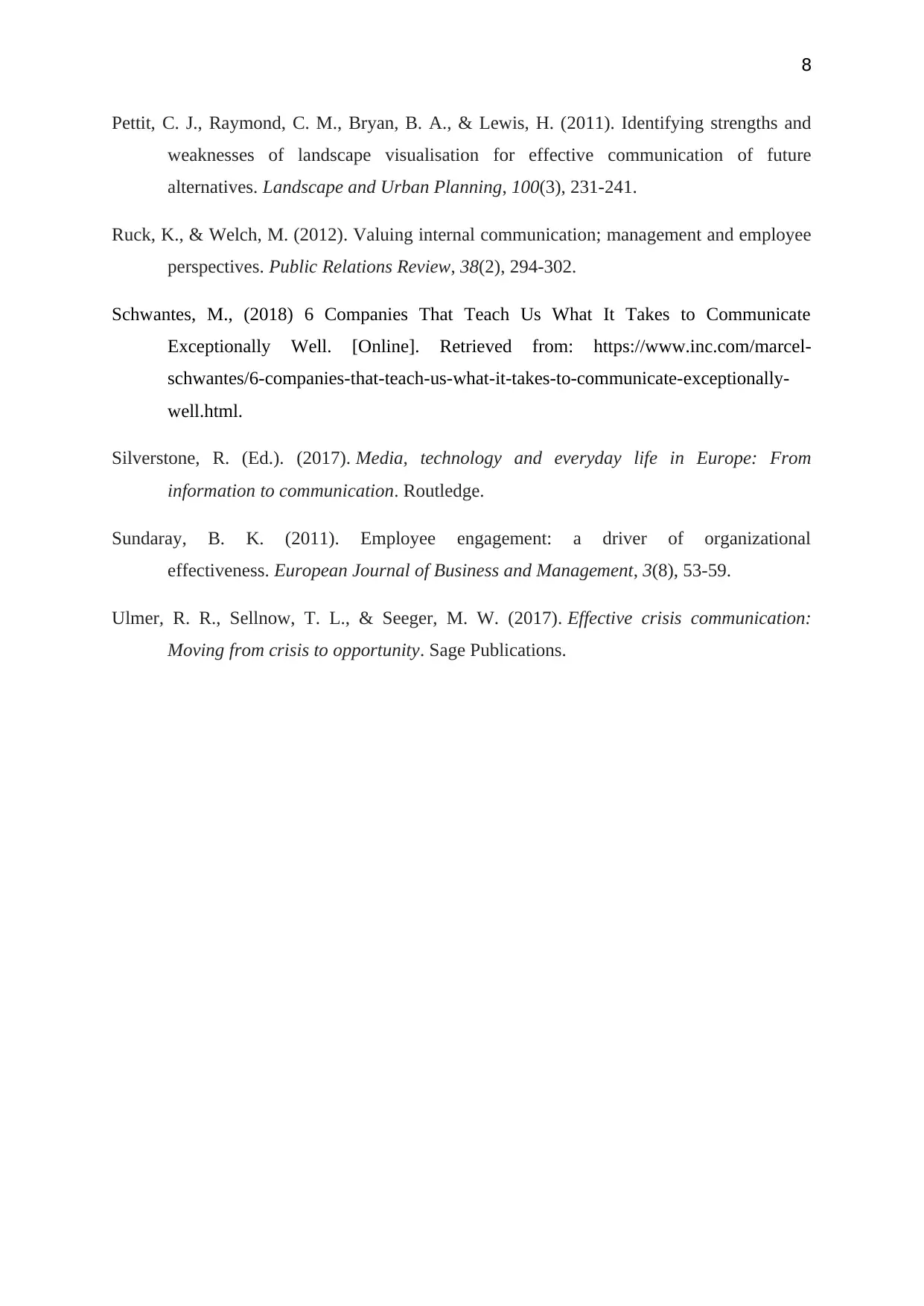
8
Pettit, C. J., Raymond, C. M., Bryan, B. A., & Lewis, H. (2011). Identifying strengths and
weaknesses of landscape visualisation for effective communication of future
alternatives. Landscape and Urban Planning, 100(3), 231-241.
Ruck, K., & Welch, M. (2012). Valuing internal communication; management and employee
perspectives. Public Relations Review, 38(2), 294-302.
Schwantes, M., (2018) 6 Companies That Teach Us What It Takes to Communicate
Exceptionally Well. [Online]. Retrieved from: https://www.inc.com/marcel-
schwantes/6-companies-that-teach-us-what-it-takes-to-communicate-exceptionally-
well.html.
Silverstone, R. (Ed.). (2017). Media, technology and everyday life in Europe: From
information to communication. Routledge.
Sundaray, B. K. (2011). Employee engagement: a driver of organizational
effectiveness. European Journal of Business and Management, 3(8), 53-59.
Ulmer, R. R., Sellnow, T. L., & Seeger, M. W. (2017). Effective crisis communication:
Moving from crisis to opportunity. Sage Publications.
Pettit, C. J., Raymond, C. M., Bryan, B. A., & Lewis, H. (2011). Identifying strengths and
weaknesses of landscape visualisation for effective communication of future
alternatives. Landscape and Urban Planning, 100(3), 231-241.
Ruck, K., & Welch, M. (2012). Valuing internal communication; management and employee
perspectives. Public Relations Review, 38(2), 294-302.
Schwantes, M., (2018) 6 Companies That Teach Us What It Takes to Communicate
Exceptionally Well. [Online]. Retrieved from: https://www.inc.com/marcel-
schwantes/6-companies-that-teach-us-what-it-takes-to-communicate-exceptionally-
well.html.
Silverstone, R. (Ed.). (2017). Media, technology and everyday life in Europe: From
information to communication. Routledge.
Sundaray, B. K. (2011). Employee engagement: a driver of organizational
effectiveness. European Journal of Business and Management, 3(8), 53-59.
Ulmer, R. R., Sellnow, T. L., & Seeger, M. W. (2017). Effective crisis communication:
Moving from crisis to opportunity. Sage Publications.
⊘ This is a preview!⊘
Do you want full access?
Subscribe today to unlock all pages.

Trusted by 1+ million students worldwide
1 out of 9
Related Documents
Your All-in-One AI-Powered Toolkit for Academic Success.
+13062052269
info@desklib.com
Available 24*7 on WhatsApp / Email
![[object Object]](/_next/static/media/star-bottom.7253800d.svg)
Unlock your academic potential
Copyright © 2020–2025 A2Z Services. All Rights Reserved. Developed and managed by ZUCOL.





